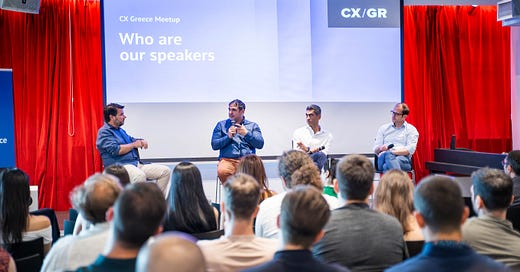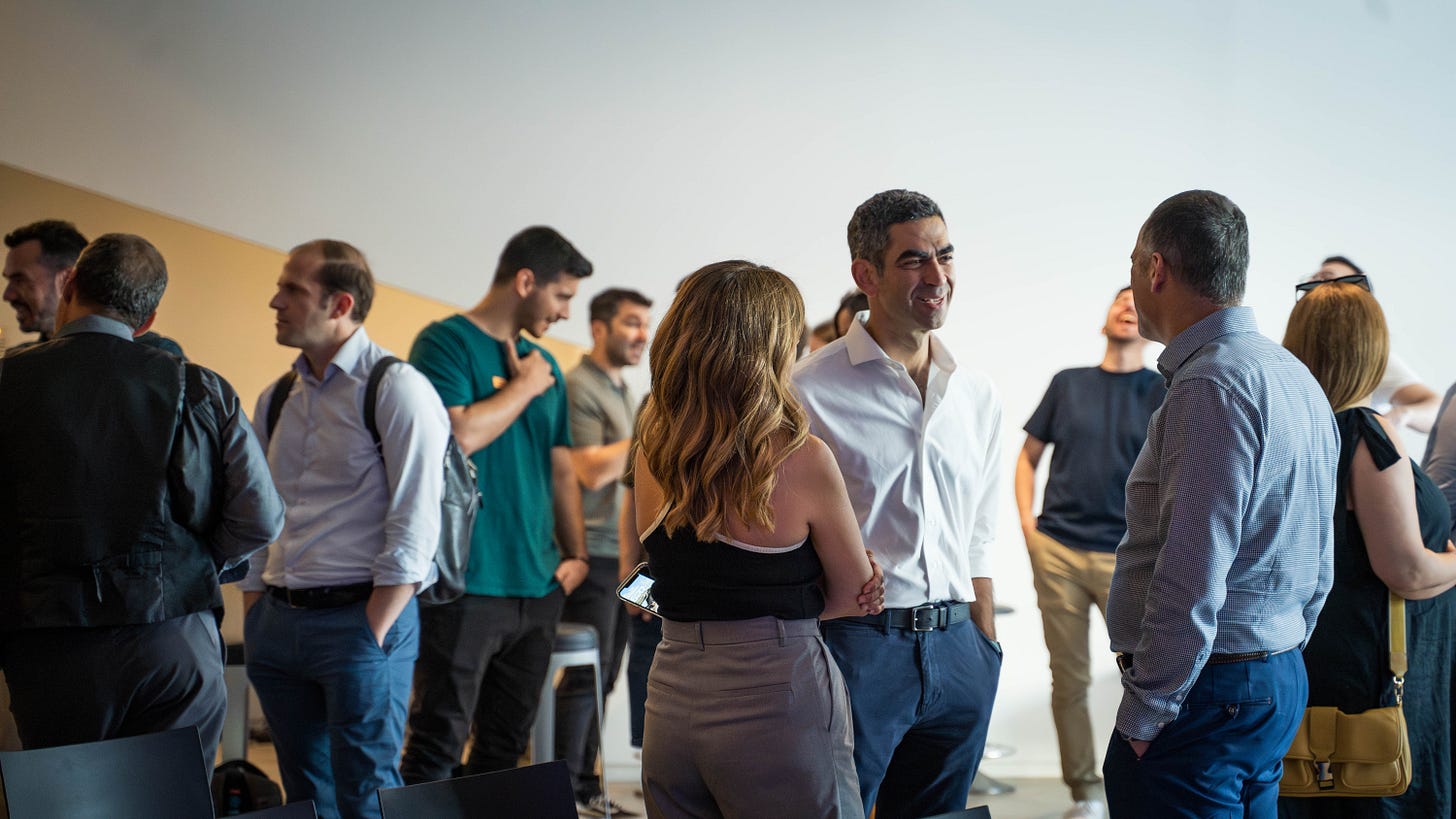CX/GR Community: What we learned from our first 2 successful meetups
Following the completion of our first two, full-house, CX/GR meet-ups in Athens, and in preparation for our third event at the end of the month, it’s time to look back at key takeaways: What makes or breaks a successful CX strategy and what are the most promising areas for growth in the industry?
For those interested in the full meetup discussions, the recorded sessions can be accessed here.
💡Follow us on LinkedIn and stay connected with all the upcoming meetups and the CX/GR Community.
#1 CX/GR Meetup: Key CX Insights from the 2 Biggest Marketplaces in GR
The launching event, held in May, featured Stefanos Katsimpas, Business Director at Skroutz Last Mile, and Konstantinos Giamalis, Chief Product Officer at efood, as speakers, with moderation by Dafni Prosalika, Principal Consultant of CX Offering at REBORRN. This event emphasized the importance of placing customers at the forefront and utilizing technology to improve overall the customer experiences. Before we dive into the key takeaways from the event, let's first introduce the two companies, which are currently the two biggest marketplaces in Greece.
Who are Skroutz Last Mile and efood
Skroutz Last Mile is the courier arm of Skroutz, delivering orders to consumers the next day. They differentiate themselves in the Greek market by placing Skroutz Points, which are lockers in the Athens area where consumers can visit and pick up their products.
On the other hand, efood started by offering food delivery and expanded to other verticals such as books, pet products, and the renowned efood market that delivers groceries to your door in less than an hour. They differentiate themselves by offering a convenient approach for users.
Both entities recognized the pivotal role of exceptional customer experiences in gaining a competitive advantage.
Crafting Effective CX Strategies
Stefanos and Konstantinos underscored the significance of customer-centricity, advocating for cultural shifts within organizations. They identified three foundational pillars for successful CX strategies:
Culture, Organizational Structure, and People: Establish a customer-centric culture within the organization and ensure that the workforce understands the importance of putting the customer's needs first.
Processes, Logistics, and Infrastructure: Optimize processes and infrastructure to ensure a seamless and hassle-free customer experience across all touchpoints.
Omni-channel Experience: Introduce an integrated and consistent customer experience across various channels, including online, mobile, and in-store.
Furthermore, the speakers emphasized the importance of training vendors and partners involved in their offerings to ensure they understand the significance of customer satisfaction and reward them accordingly.
Stefanos and Konstantinos advised that when developing new CX features, it is essential to start with a basic MVP (Minimum Viable Product) that includes the most important functionalities rather than overcomplicating things. This approach ensures that the CX features are simple, user-friendly, and effectively cater to the user's needs.
Technology Integration for Enhanced CX
Konstantinos and Stefanos discussed the crucial role of technology in elevating customer experiences. They proposed a hybrid model combining in-house and third-party solutions for optimal results.
In terms of building features, the duo stressed the importance of taking a common-sense approach and keeping an eye on competitors and other popular applications. They also discussed the significance of staying up-to-date with global market trends and gaining a deeper understanding of customer touchpoints through direct interaction.
The same importance of taking a common-sense approach is also regarding data. This step is essential for translating data into actionable insights that can drive meaningful change.
While Artificial Intelligence (AI) is a buzzword in the tech industry, the duo cautioned that its impact on customer experience is currently limited. Nonetheless, they suggested incorporating it into your tech stack to stay ahead of the curve.
#2 CX/GR Meetup: Navigating CX Transformation: From Tradition to Innovation
After understanding the perspective of two "scale-up-oriented" companies, the focus shifted to how traditional companies are evolving and navigating CX transformation for the second meetup. Held in July, this meetup featured Ernestos Panayiotou, General Manager - Chief Transformation Officer at National Bank of Greece; Panos Tsonis, General Manager at G4S Telematix; and Nikos Varvadoukas, VP Brand, Customer & Omnichannel at Public Group. Costas Mantziaris, Co-Founder and Managing Partner at REBORRN, moderated the discussions, exploring challenges, best practices, and the role of culture in driving change.
Understanding NBG, G4S Telematix and Public Group
The National Bank of Greece (NBG), the largest and oldest commercial bank in Greece, is playing a pivotal role in the country's financial system and offering a range of banking and financial services to individuals, businesses, and institutions.
Moving to the second featured company, G4S Telematix is a division of the global security company G4S that specializes in providing advanced technology solutions for vehicle tracking, fleet management, and telematics services. These services enable businesses to monitor and optimize their fleet operations, enhance driver safety, and improve overall efficiency through the utilization of real-time data and analytics.
Public Group's flagship venture, Public, is the leading omnichannel retailer in Greece and Cyprus with sales of more than €500 million, 67 physical stores and a state-of-the-art eCommerce platform. It is a unique destination that combines the best products in culture, technology and home appliances with innovative services fit for the modern consumer.
The Role of Culture in CX Transformation
Throughout the discussions, everyone agreed that culture stands as the bedrock of successful transformation within sizeable organizations.
In NBG's transformation case, the strategy involved a bottom-up approach, with cross-functional teams fostering a collective mindset shift. A core group of 500 employees worked collaboratively, aligning objectives and milestones. This approach challenged the company's traditional practices, ultimately leading to a more customer-centric mindset. This mindset change, although initiated by a smaller group, influenced the broader company culture, emphasizing collaboration and client perspective.
On the other hand, G4S Telematix, while smaller than the other companies, benefited from an existing culture of customer proximity. As Panos explained, adopting a top-down strategy, the company conveyed a clear message of strategic transformation from leadership. They capitalized "People Accelerators," individuals at the forefront of the transformation, who played the primary role in driving change. This approach gained trust and established new working standards, serving as a model for the entire organization.
In the context of Public Group, Nikos shared the three key cultural changes the company implemented. Beginning with adopting a customer-focused vision across all areas of the business, they then incorporated Net Promoter Score (NPS) objectives into each role, highlighting shared responsibility for the customer experience. Finally, they introduced startup-inspired practices, cultivating an open, inventive, and flexible environment that encourages creativity.
Strategies for Effective Transformation
A successful transformation never started with big announcements, but with a strong focus on the central role of implementation as the main strategy. This involves assigning resources and focused work before revealing progress, all while highlighting accomplishments within the team.
Building on the above insights, Panos highlighted the significance of setting measurable goals and steadily reaching them, sounding a note of caution against disruptive changes that could cause a bigger problem than a solution. As G4S, they advocated for gradual demonstrations of progress to inspire and ultimately enrich the customer experience.
Ernestos also emphasized that successful implementation is the ultimate goal, with the CEO's mindset spreading throughout the entire organization. Thoughtful communication emerged as a key factor, important for both internal motivation and external representation of structured accomplishments. Their approach included early adoption of digital changes, backed by significant investments, which greatly improved their industry reputation and functional abilities.
Lastly, Nikos underscored the necessity of initially concentrating on delivery, cultivating the organization's conviction in the feasibility of transformation over time. Consistent pacing, harnessing sprint strategies, and upholding a weekly rhythm of change is essential for ensuring the team's comprehension and engagement.
All speakers agreed on the concept of keeping a steady pace during industry changes and prioritizing battles based on competition and resource allocation is crucial.
Omnichannel and Post-COVID Challenges
A shared reality is that transitioning from online shopping to data-driven business presents challenges in invoicing, orders, and comprehending customer behavior. Certain transaction components lack data, such as loyalty programs and digital receipts. This signifies a new era where customer data holds significant importance.
As more transactions move online, the need of in-person interaction remains, adjusting to each customer's preferences.The blending of self-service and digital platforms ensures a seamless experience, yet challenges arise in managing in-store encounters.
Navigating the digital landscape introduces complexities, demanding structured information; however, this journey necessitates human oversight for thorough verification. In this era, data takes the lead, guiding decisions and shaping the future.
To Wrap Up
The journey towards effective CX transformation entails embracing change, fostering a collaborative culture, and committing to continuous improvement. Overall, the meetups were an excellent opportunity to learn from experienced professionals and gain a deeper understanding of the importance of a holistic approach to customer experience.
📆 Be sure to stay tuned, as a series of forthcoming meetups are set to unfold in the upcoming months. Mark your calendars already, as the #3 CX/GR Meetup is going to take place in the final week of September.
Feel free to share your thoughts and provide input to the community by leaving a comment.






